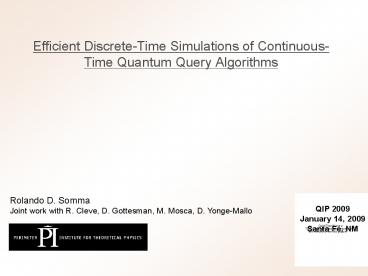Step 1: Discretization using a (first order) Suzuki-Trotte - PowerPoint PPT Presentation
1 / 25
Title:
Step 1: Discretization using a (first order) Suzuki-Trotte
Description:
Step 1: Discretization using a (first order) Suzuki-Trotter approximation ... Step 1: Trotter-Suzuki Approximation. Output gives some property of. Algorithm in ... – PowerPoint PPT presentation
Number of Views:84
Avg rating:3.0/5.0
Title: Step 1: Discretization using a (first order) Suzuki-Trotte
1
Efficient Discrete-Time Simulations of
Continuous-Time Quantum Query Algorithms
Rolando D. Somma Joint work with R. Cleve, D.
Gottesman, M. Mosca, D. Yonge-Mallo
QIP 2009 January 14, 2009 Santa Fe, NM
2
Query or Oracle Model of Computation
Given a black-box (BB)
BB
Want to learn a property of the N-tuple
3
Query or Oracle Model of Computation
Oracle models are useful to obtain bounds in
complexity and to make a fair comparisson
between quantum and classical complexities
4
Continuous-Time Quantum Query Model of Computation
Query cost
1- Query Hamiltonian
fractional query
2- Time-dependent Driving Hamiltonian (known) 3-
Evolution time (or total query cost) Tgt0
M
Output gives some property of
M
M
M
M
M
E. Farhi and S. Gutmann, Phys. Rev. A 57, 2043
(1998)
5
Motivations
- Some quantum algorithms have been discovered in
the continuous time query model - Exponential algorithmic speed up by quantum
walk, Childs et. al. - Proc. 35th ACM Symp. On Th. Comp. (2003)
Given an oracle for the graph, and the name of
the Entrance. Find the name of the Exit.
6
Motivations
- Some quantum algorithms have been discovered in
the continuous time query model - A Quantum Algorithm for Hamiltonian NAND tree,
Farhi, Goldstone, Gutmann - quant-ph/0702144
N
The query Hamiltonian is built from the adjacency
matrix of a graph determined by the tree and the
input state. It outputs the (binary) NAND in time
7
Motivations
Is it possible to convert a quantum algorithm in
the CT setting to a quantum algorithm in the more
conventional query model?
8
MAIN RESULTS
Theorem Any continuous-time T-query algorithm
can be simulated by a discrete-time O(T log T
)-query algorithm
Corollary Any lower bounds on discrete query
complexity carry over to continuous query
complexity within a log factor
9
Quantum Algorithm Overview
The construction has many steps
- Step 1 Discretization using a (first order)
Suzuki-Trotter approximation - Step 2 Probabilistic simulation of fractional
queries using (low-amplitude) - controlled discrete queries
- 1 and 2 yield simulations of cost
O(T2) - Step 3 Reduction on the amount of discrete
queries by disregarding high- - Hamming weight control-qubit states
- Step 4 Correction of errors due to step 2
10
Step 1 Trotter-Suzuki Approximation
Algorithm in the CT setting
Output gives some property of
M
M
M
M
M
11
Step 1 Trotter-Suzuki Approximation
U1
U2
U3
M
M
M
M
M
Step 1 Fidelity
Still pgtgtT fractional queries
It doesnt work in general
12
Step 2 Probabilistic Simulation of Fractional
Queries
13
Step 2 Probabilistic Simulation of Fractional
Queries
U1
U2
U3
M
Up
M
M
M
M
14
Step 3 Reducing the amount of queries
We break the circuit in segments of size m
R1
M
R2
R1
M
R2
R1
R2
M
R1
R2
M
U1
U2
U3
M
M
M
M
M
m queries
15
Step 3 Reducing the amount of queries
R1
M
R2
m
R1
R2
M
R1
R2
M
U1
U2
U3
Um
m queries
Density of states
16
Step 3 Reducing the amount of queries
R1
R1
m
R1
U1
U2
U3
m queries
Density of states
Hamming weight cutoff
At most kltltm full queries are needed !
Average Alt1/2
17
Step 3 Reducing the amount of queries
m full queries
18
Step 3 Reducing the amount of queries
Asks the value of the Hamming weight
m
Vj
Implements the desired sequence of Us
Example
m
V2
U2
U3
Um
19
Step 3 Reducing the amount of queries
We build Step 4 to error correct and increase the
probability of success towards 1
20
Step 4 Error correction
R1
M
R1
m
M
R1
M
U1
U2
U3
m queries
21
Step 4 Error correction
1- We undo the circuit 2- We redo it
Both, the undoing and redoing parts require the
simulation of fractional queries with phases ?.
Therefore, to reduce the total amount of queries,
each of these operations have to be simulated
probabilistically as explained in step 2.
22
Step 4 Error correction
The probability of success increases towards 1
exponentially fast with k
23
Step 4 Error correction
Because the size of the tree associated to the
branching process is a O(1) constant, to succeed
with probability (say) 1- ?3 , we need to
simulate O(T/ ?3) circuits ONLY.
Each of the circuits in the branching process (of
size m or smaller) is simulated using the trick
of step 3 to reduce the amount of queries
24
Complexity of the simulation
25
Step 5 Conclusions!
Improvements?































